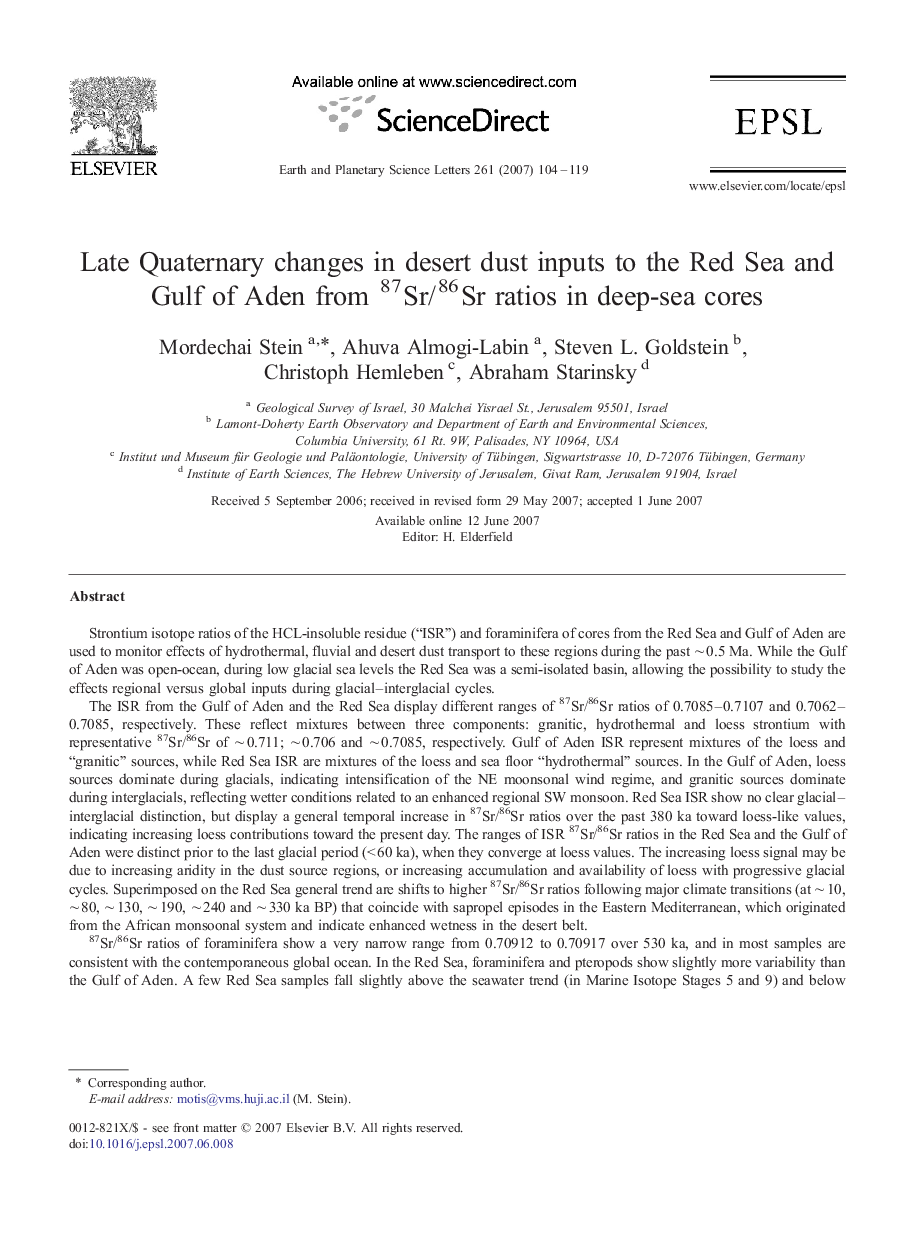| کد مقاله | کد نشریه | سال انتشار | مقاله انگلیسی | نسخه تمام متن |
|---|---|---|---|---|
| 4680224 | 1634913 | 2007 | 16 صفحه PDF | دانلود رایگان |

Strontium isotope ratios of the HCL-insoluble residue (“ISR”) and foraminifera of cores from the Red Sea and Gulf of Aden are used to monitor effects of hydrothermal, fluvial and desert dust transport to these regions during the past ∼ 0.5 Ma. While the Gulf of Aden was open-ocean, during low glacial sea levels the Red Sea was a semi-isolated basin, allowing the possibility to study the effects regional versus global inputs during glacial–interglacial cycles.The ISR from the Gulf of Aden and the Red Sea display different ranges of 87Sr/86Sr ratios of 0.7085–0.7107 and 0.7062–0.7085, respectively. These reflect mixtures between three components: granitic, hydrothermal and loess strontium with representative 87Sr/86Sr of ∼ 0.711; ∼ 0.706 and ∼ 0.7085, respectively. Gulf of Aden ISR represent mixtures of the loess and “granitic” sources, while Red Sea ISR are mixtures of the loess and sea floor “hydrothermal” sources. In the Gulf of Aden, loess sources dominate during glacials, indicating intensification of the NE moonsonal wind regime, and granitic sources dominate during interglacials, reflecting wetter conditions related to an enhanced regional SW monsoon. Red Sea ISR show no clear glacial–interglacial distinction, but display a general temporal increase in 87Sr/86Sr ratios over the past 380 ka toward loess-like values, indicating increasing loess contributions toward the present day. The ranges of ISR 87Sr/86Sr ratios in the Red Sea and the Gulf of Aden were distinct prior to the last glacial period (< 60 ka), when they converge at loess values. The increasing loess signal may be due to increasing aridity in the dust source regions, or increasing accumulation and availability of loess with progressive glacial cycles. Superimposed on the Red Sea general trend are shifts to higher 87Sr/86Sr ratios following major climate transitions (at ∼ 10, ∼ 80, ∼ 130, ∼ 190, ∼ 240 and ∼ 330 ka BP) that coincide with sapropel episodes in the Eastern Mediterranean, which originated from the African monsoonal system and indicate enhanced wetness in the desert belt.87Sr/86Sr ratios of foraminifera show a very narrow range from 0.70912 to 0.70917 over 530 ka, and in most samples are consistent with the contemporaneous global ocean. In the Red Sea, foraminifera and pteropods show slightly more variability than the Gulf of Aden. A few Red Sea samples fall slightly above the seawater trend (in Marine Isotope Stages 5 and 9) and below (during the last deglaciation), suggesting local effects that occurred when the flow of surface ocean water from the Gulf of Aden to the Red Sea was limited and the Red Sea behaved like an “amplifier basin”.
Journal: Earth and Planetary Science Letters - Volume 261, Issues 1–2, 15 September 2007, Pages 104–119